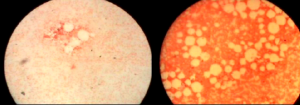Aplastic Anaemia
Staining of bone marrow for iron to visualise red blood cells

HB (Haemoglobin) g/dl
- Patient A
- Patient B
- Patient A
- Patient B
Platelets 10^3/µl
- Patient A
- Patient B
- Patient A
- Patient B
Neutrophils 10^3/µl
- Patient A
- Patient B
- Patient A
- Patient B
Aplastic Anaemia is a rare disease of the bone marrow. It occurs when the bone marrow stops making sufficient red blood cells, white blood cells and platelets for the body. Any blood cells the marrow does make are normal, but there are not sufficient numbers of them for normal functioning of the haematopoietic system; the blood forming stem cells within the bone marrow are replaced by fat cells.
Red blood cells, white blood cells and platelets, which are normally produced in the bone marrow, decrease to dangerously low levels. The condition leads to fatigue, shortness of breath, cardiac symptoms; bruising and mucosal bleeding; and increased susceptibility to infection.
Treatment includes transfusions, treatment of infections, bone marrow transplant, immunosuppressive therapy, or a combination of these.
Untreated, Aplastic Anaemia leads to death. As many as 50% of diagnosed patients die within 15 months of diagnosis, and 70% die within 5 years. If the disease is diagnosed correctly and initial treatment is begun promptly, then the survival rate for the next five to ten years is substantially improved. For example, the probability of becoming transfusion independent following immunosuppressive therapy may vary from 40% to 80% depending on the drug regimen and the patient population. Following a bone marrow transplant, overall survival at 10 years is in the range 51%-83% depending on age.
TriStem’s clinical study
Four patients were treated with a single infusion of stem cells created from their own white blood cells using TriStem’s technology. Two of the four patients with aplastic anaemia became transfusion independent for more than seven years.
The results were published in a peer-reviewed paper, which can be accessed here.
Two patients are still alive and transfusion-independent more than 10 years after receiving the TriStem cells
